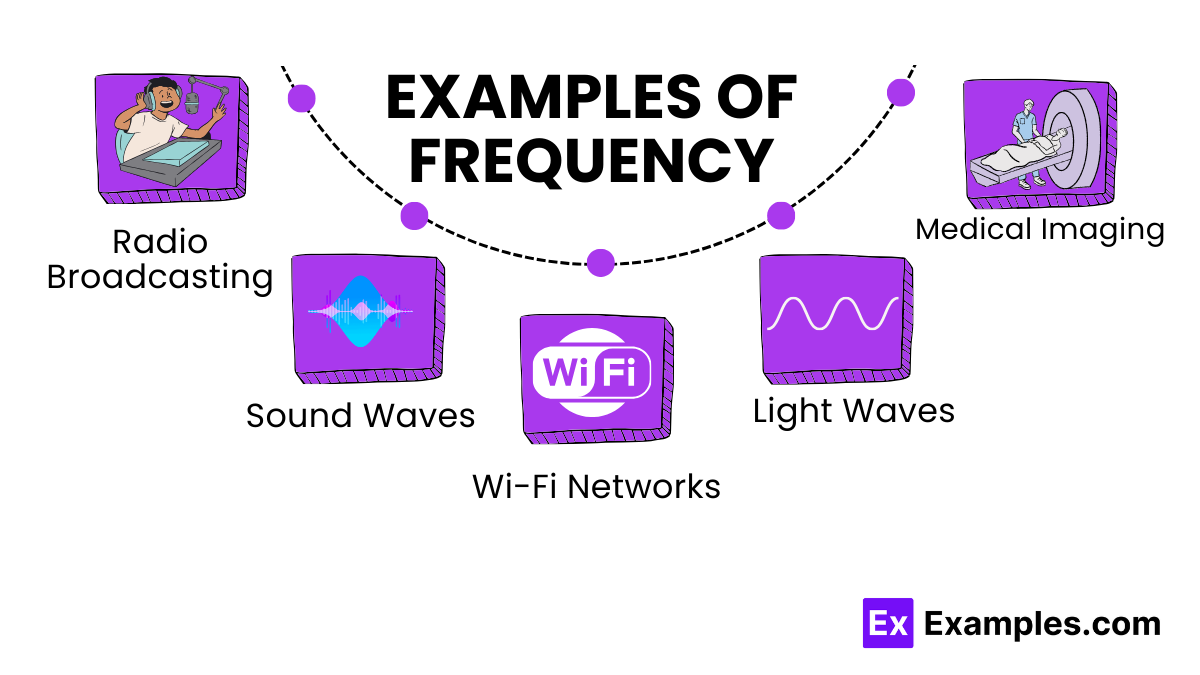What is the unit of frequency in the International System of Units (SI)?
Hertz
Newton
Joule
Watt


Frequency refers to the number of complete cycles of a periodic event that occur in a specific unit of time. In the context of waves, like sound waves or light waves, it measures how many waves pass a point each second. Frequency is commonly expressed in units called hertz (Hz), where one hertz equals one cycle per second. This concept is crucial in physics, engineering, and various technology fields, helping to describe how often an event repeats over time.
Frequency (f) = Number of Cycles (n) / Time (t)

The formula for frequency is used to calculate how often something occurs within a specific interval of time. It is commonly expressed as:
f = 1/T
f = v/λ
f=ω/2π
Frequency in Terms of Time Period:
Frequency in Terms of Wavelength and Wave Speed:
Frequency in Terms of Angular Frequency:
Frequency is measured in units called hertz (Hz), where one hertz represents one cycle per second. This is the standard unit used internationally to indicate the number of times a periodic event occurs per second.
Besides hertz, frequency can also be expressed in multiples that reflect higher or lower values, such as:
These units are commonly used in various contexts, like radio frequencies, computer processors, and the transmission of digital data. The choice of unit typically depends on the frequency of the phenomenon being measured. For example, radio stations often broadcast at frequencies in megahertz, while computer CPUs operate in gigahertz.

The relationship between frequency and energy is a fundamental concept in physics, particularly evident in the behavior of waves and quantum mechanics. Here’s how frequency relates to energy:
The direct proportionality of frequency and energy has significant implications in technology, medicine, and natural phenomena. For instance, in medical imaging, different frequencies of electromagnetic waves are chosen based on the energy levels required to penetrate body tissues without causing harm. In communication technology, the choice of frequency impacts the energy use and range of the transmission.
| Property | Description |
|---|---|
| Frequency (f) | The number of cycles of a wave that pass a point per second, measured in hertz (Hz). |
| Wavelength (λ) | The distance over which the wave’s shape repeats, measured in meters (m). |
| Relation | Frequency and wavelength are inversely proportional to each other in a wave. This means when the frequency increases, the wavelength decreases, and vice versa. |
| Formula | The relationship is given by the formula v=f×λ, where v is the wave speed in meters per second (m/s). |
| Implication | Knowing one of these properties and the speed of the wave allows you to calculate the other. This is crucial in fields like physics, engineering, and telecommunications. |
Text prompt
Add Tone
10 Examples of Public speaking
20 Examples of Gas lighting
What is the unit of frequency in the International System of Units (SI)?
Hertz
Newton
Joule
Watt
If a wave has a frequency of 10 Hz, what is its period?
1 second
0.1 seconds
10 seconds
0 .01 seconds
A sound wave has a frequency of 440 Hz. What is its wavelength if the speed of sound is 340 m/s?
0.77 meters
1.00 meters
0.77 centimeters
1.00 centimeters
Which of the following frequencies is considered in the audible range for humans?
20 Hz
1 kHz
5 kHz
All of the above
What is the frequency of a wave if its period is 0.25 seconds?
2 Hz
4 Hz
0.25 Hz
1 Hz
If the frequency of an electromagnetic wave is increased, what happens to its wavelength?
It increases
It decreases
It stays the same
It doubles
What frequency range is typically used for FM radio broadcasting?
530 kHz to 1.7 MHz
88 MHz to 108 MHz
300 GHz to 400 GHz
1 Hz to 20 Hz
Which frequency range corresponds to the microwaves used in microwave ovens?
30 MHz to 300 MHz
1 GHz to 30 GHz
3 kHz to 30 kHz
300 THz to 400 THz
If a wave with a frequency of 50 Hz has a wavelength of 4 meters, what is the speed of the wave?
12.5 m/s
200 m/s
50 m/s
100 m/s
The human ear can detect frequencies ranging from:
1 Hz to 1000 Hz
20 Hz to 20 kHz
10 kHz to 100 kHz
0.1 Hz to 1 Hz
Before you leave, take our quick quiz to enhance your learning!

